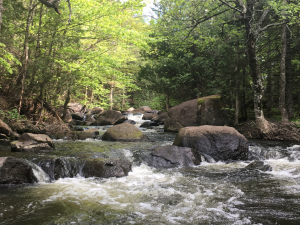Septic tank maintenance
Do you empty your septic tank every two years? You should if you live in your home year-round. For seasonal dwellings (180 days or less per year), the tanks should be emptied every four years. This process removes solids that could compromise the efficiency of your septic tank and allow toxins to spread. The area between the leach field and the shoreline should be wooded to help filter the nutrient-rich water.
Save water (heavy water use precipitates circulation in the septic tank, preventing the separation of sludge). Do not flush or pour down the drain any substances or products that do not decompose naturally or break down easily, such as tissues and paper towels, oil and grease, antibacterial soap and other disinfectants, bleach and other corrosive detergents, solvents and paint.
Construction projects
If you are thinking about renovating your dwelling or putting up a new building, you must inform your contractor about current environmental regulations and directives. An ill-conceived construction project could result in disastrous erosion damage.
Permits and certificates of authorization
According to the town planning by-laws of the Municipality of Morin-Heights, when you apply for a permit or certificate of authorization, you must provide all the plans and documents describing your project in detail. You need to consult the building inspector to make sure that you have all the documents and information required to obtain a permit or certificate of authorization.
Permits and certificates of authorization are usually required for the following activities: new construction, docks and rafts, extensions, antennas, repurposing, excavation, septic tanks, pools, carports, fences, hedges, low retaining walls, demolition, driveways, structural changes to roofs, moving a structure, minor repairs valued at more than $500, replacement of doors or windows, tree planting or cutting, signage, garages, garden sheds and public service buildings.
You also need a permit to drill a well, install or replace sanitary facilities and carry out work related to water use near a waterway.
Shoreline maintenance
What do you have to do to maintain a riparian buffer strip? Not much. Most of us don’t need to do anything, just let nature take its course. Others may need to help Mother Nature by “renaturalizing” the buffer strip.
Water quality is directly related to the water’s surrounding vegetation, which creates shade, provides a natural windbreak, regulates water levels, stabilizes the shoreline through root systems, and filters out nutrients and pollution. A vegetated shoreline also plays a key landscaping role. Riparian vegetation makes for beautiful landscapes.
For more information . . .
- Entrepreneurs, avant d’intervenir près d’un lac, d’un cours d’eau ou d’un milieu humide… renseignez-vous ! (in French only)
- La gestion de l’aménagement en plaine inondable resserrée par des modifications à la Politique de protection des rives, du littoral et des plaines inondables (in French only)
- Bande riveraine – Plantation et entretien : pour une restauration durable! (FIHOQ) (in French only)
Become a conservationist
If you want to take part in the conservation of your property, take the first step by obtaining an environmental assessment of your property in the form of an Owner’s Booklet.
Depending on your needs, a conservation option might address your situation and interests. Examining conservation options and choosing a conservation tool would also help ensure the long-term protection of your property’s ecological features. This will benefit you and the entire community.
Support from our team!
The Ruisseau Jackson – Protected Natural Area (RJANP) team can help you with your natural area protection and enhancement projects. Whether you want to organize an interpretive walk on your property, develop a natural wildlife habitat or install nesting boxes, or would like some guidance on legal conservation options, the board of directors can provide support and put you in touch with the right people.

Ruisseau Jackson… Natural filter — Biodiversity — Collective identity
